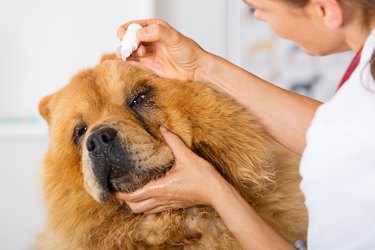Whether it's the pollen-filled spring air or dry indoor days throughout the winter, dogs develop allergies or dry eyes just like humans. Before using your own eye drops on your pet, talk to your veterinarian. Most eye drops made for people are not approved for use in dogs. It's not a good idea to give your pet any over-the-counter medication or supplements that are not prescribed by the veterinarian.

Video of the Day
Dog eye allergy treatment may include eye drops, but there are specific formulas designed for use in canines. Due to the nature of dog eye problems, there can be many causes behind tearing, discharge, or dryness, so it's important to find the cause before treating the issue. In general, things made for humans or other animals should not be safe for dogs, and you should always ask your veterinarian before using over-the-counter medications or treatments on your pet.
Video of the Day
Dog eye issues
Keratoconjunctivitis Sicca, commonly known as KCS or dry eyes, causes corneal swelling due to lack of moisture. When dogs have dryness in their eyes, their body often makes excess tears to lubricate and relieve the discomfort. Any dog can develop this condition, but certain breeds are more prone to it.
If your dog has clogged tear ducts, he may have excessive tearing and tear stains on the fur surrounding the eyes. In severe cases of lacrimal duct obstruction, or blocked tear ducts, bacteria can grow, leading to infections and hair loss near the eye. Flushing out the tear duct with a probe can clear the blockage to help tears begin flowing normally again. When left untreated, tears will continue, and infection can occur.
Conjunctivitis, or pink eye, is the inflammation of the conjunctiva in a dog's eye. Leading to redness and discharge, this eye issue is usually caused by a viral infection, like parvovirus, but can also be a side effect of eye trauma, tumors, immune disorders, or clogged tear ducts. Since there are so many potential causes behind pink eye in dogs, it's important to have a veterinarian evaluate your pet and come up with a treatment plan for both the condition and the cause.
Treatments for dog eye problems
Depending on the type of eye infection or injury, veterinarians will prescribe medication or order a procedure. In addition to recommending dog-safe eye drops, treatment can include antibiotics, surgery, or medications. A foreign substance in the eye will require removal. Dry eye issues may be treated with a procedure to encourage tear production.
While you may be wondering, "Can Visine be used on dogs?" or if those Opticon eye drops in your medicine cabinet can work the same for your pet, do not try to make a treatment plan with what you have at home. You should only use eye drops for pet allergies or other eye conditions that are recommended by your pet's veterinarian to treat the specific condition.
Special allergy eye drops for dogs are available. Formulas with steroids are available for eye issues, such as cataracts or glaucoma. Prescription strength, medicated dog eye drops for moisture and pain relief are also available.
Applying allergy drops for dogs
Once you are given a prescription for eye drops, it's time for the fun part. Putting eye drops in your dog's eyes can be challenging and stressful for everyone involved, but remaining calm and rewarding your dog with treats can make the process go quickly so that the moisture or medication can start soothing your canine's sore eyes immediately.
Before giving your dog the eye drops, clean the eye area. Use one hand to hold your dog's hand still and pull her eyelid down, using the other hand for the dropper. You'll want to hold the bottle close to her eyeball for application but do not let it touch, as this can contaminate the dropper with bacteria from your dog's eye infection.